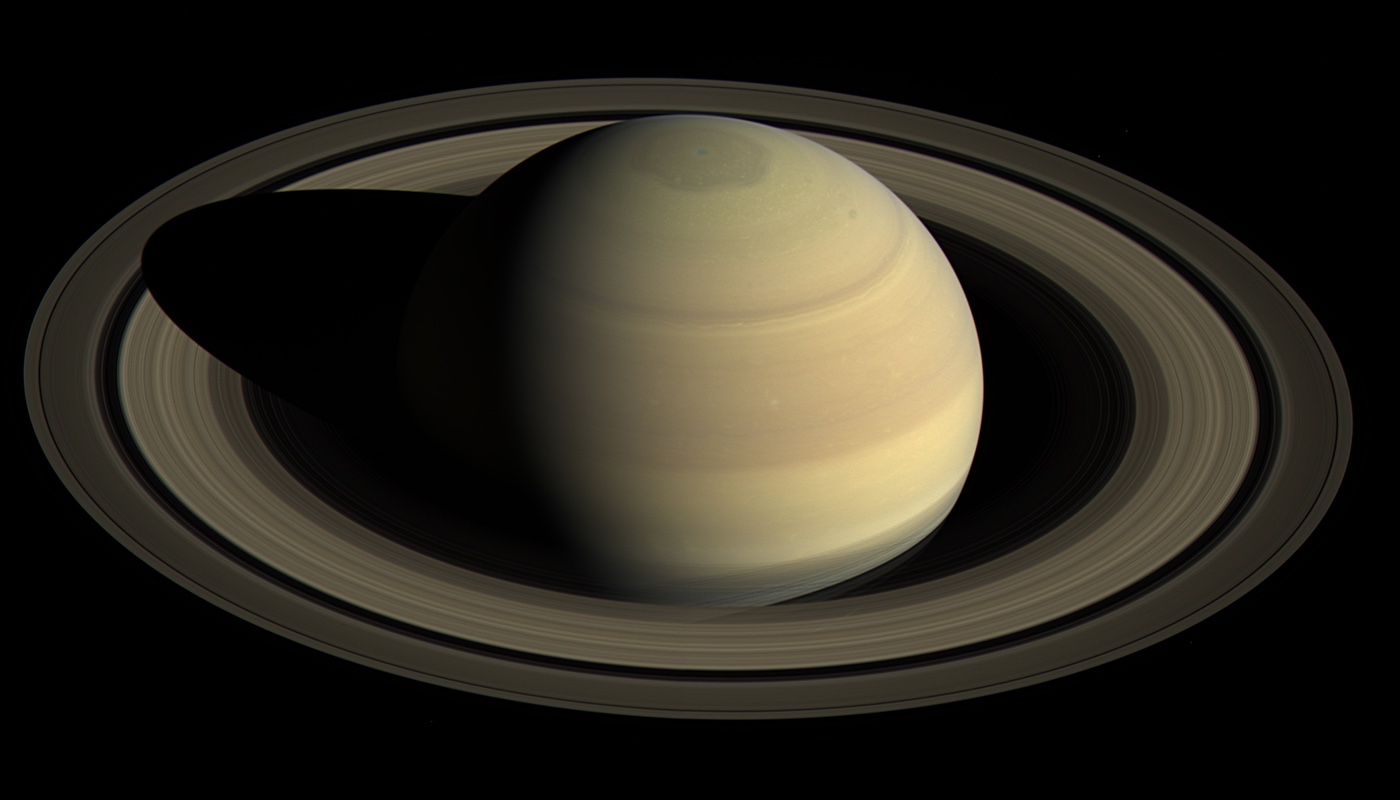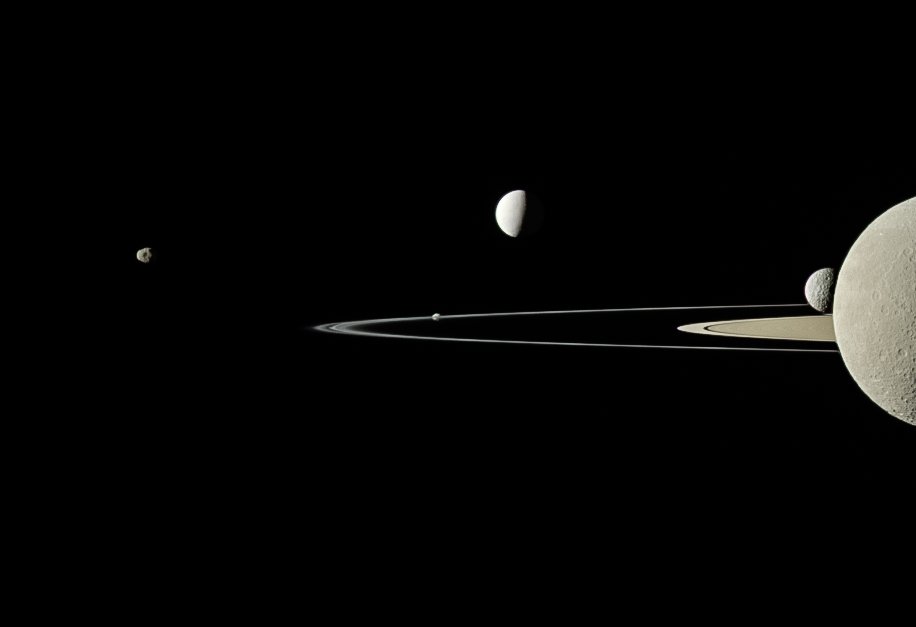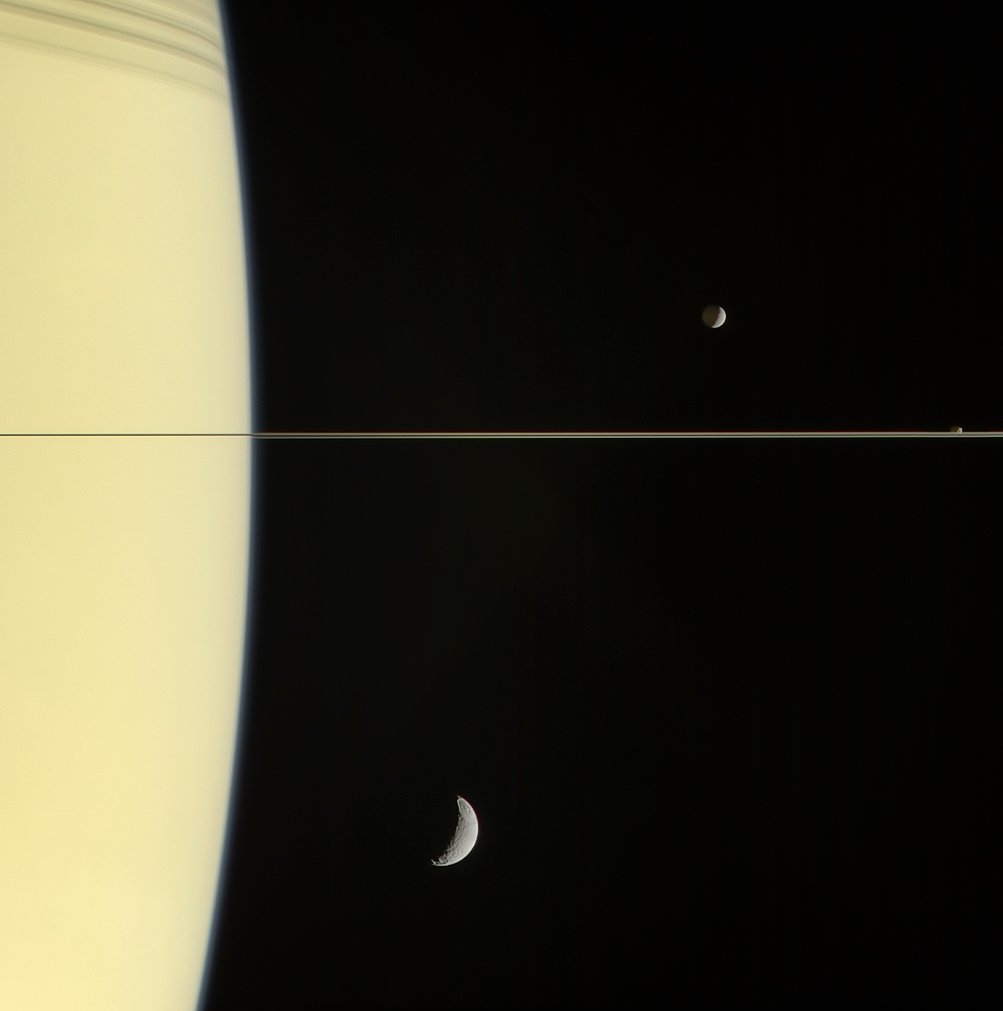How Old Are Saturn's Rings? The Debate Rages On.

Of our solar system's wonders, one reigns as the emblem of all that is alien and otherworldly: the majestic rings of Saturn, rising resplendent and shimmering above the giant planet's buttery, cloud-crossed face.
Stretching nearly 300,000 kilometers from tip to tip and containing countless icy particles ranging in size from "microscopic" to "mobile home," the rings make Saturn undeniably eye-catching. But more than mere decoration, they are one of the most enduring enigmas in planetary science. Put simply, experts cannot agree on how the rings formed or even how old they are. Are Saturn's bangles a primordial feature of the solar system, having emerged roughly 4.5 billion years ago when chaos and collisions sculpted much of what we see today? Or did they arise much more recently?
The answer not only matters for scientists working to understand planetary rings and reconstruct the solar system's history; it could have dizzying implications for astrobiologists wondering whether alien life might thrive beneath the icy crust of Enceladus, a small inner moon of Saturn whose buried, global sea is considered one of the best places to look for biology beyond Earth.
Though not definitive, the best available data to settle the debate came during the final years of NASA's Cassini spacecraft, which orbited Saturn from 2004 to 2017. Based on Cassini's measurements of the rings' mass and brightness, many scientists now believe they are remarkably youthful, having burst into existence perhaps as recently as 100 million years ago, when dinosaurs still roamed the Earth—which means that, viewed through some saurian telescope, Saturn could have been bizarrely bereft of rings.
But not everyone is convinced; it is just too hard, some critics say, to craft such expansive rings in the relatively placid solar system of now and near-yesteryear.
"I have no objection to young rings. I just think no one has found a very plausible way of making them," says ring expert Luke Dones of the Southwest Research Institute. "It requires an unlikely event."
A Decades-Old Debate
Today's debate over the provenance of Saturn's rings traces its origin to several decades ago, chiefly to the first close-up reconnaissance of the system by the interplanetary Voyager 1 and Voyager 2 missions. Those observations hinted that the rings were surprisingly light, lacking sufficient heft to have retained their pearly gleam across the solar system's multibillion-year history. The rings, it seemed, were quite young—but theorists struggled to devise a mechanism to explain their relatively recent formation.
Get the world’s most fascinating discoveries delivered straight to your inbox.
Then came Cassini. Towards the mission's end, the spacecraft performed two dozen daring dives between Saturn's cloud tops and the ring system's innermost edge. As it threaded that needle, Cassini carefully measured the mass of the rings and came up with a number similar to Voyager's: roughly half the mass of Mimas, a small icy moon bearing uncanny resemblance to the "Death Star" space station from Star Wars.
But that is only part of the story. Earlier in its mission, the spacecraft had also grazed the edges of the rings, scooping up dust and other particles to help estimate how much dark debris the structures sopped up from their surroundings—another crucial measurement for pinning down their age. Like its measurements of the system's mass, Cassini's readings of dust in Saturn's vicinity further hinted at youthful rings: Despite being continually dusted by dark debris shed by dingy objects in the outer solar system, Saturn's rings of water ice are still bright white. As the logic goes, the older the rings, the darker they should be—unless they are massive enough to somehow accumulate dark dust over billions of years, while still maintaining their youthful gleam.
Robin Canup, of the Southwest Research Institute, refers to this line of evidence as the "pollution argument" for young rings. "The fact that the rings are bright tells us in some way that they have not been efficiently polluted, or at least that we don't see the evidence of that," she says.
Additional observations suggest that not only are the rings absorbing material, they are also losing it in massive quantities, constantly sending showers of icy particles into the planet's atmosphere. In fact, with one estimate suggesting such showers could deplete the rings within 300 million years, it seems that Saturn's most distinctive feature could be surprisingly transient indeed.
"The idea that they could be around for 4.5 billion years really defies explanation in my mind," says Erik Asphaug of the University of Arizona, who studies interactions between Saturn's rings and its many moons.
Young Rings, Made to Order
Even so, many compelling arguments remain against Saturn's supposedly youthful rings. Making such an expansive ring system so recently, it turns out, is no small task; the odds are stacked against it. Sure, the planet could have shredded a passing cometin whole or in part, scattering the stripped remains into rings; or, yes, maybe an interloping object smashed into one of Saturn's moons, forming rings from the splattered, pulverized moon-bits. But to any honest theorist, such made-to-order scenarios smack of special pleading.
"We do have a pretty good idea, a census, of how many comets are flying around the outer solar system, and you just don't have enough of them to make that scenario likely," Dones says. "Within the last hundreds of millions of years, the chance of that is maybe a few percent."
But suppose instead that no comets were involved at all—that the ring's parent bodies originated entirely from within rather than outside the Saturnian system. While studying the curious orbits of the planet's close-in moons, the SETI Institute's Matija Ćuk and his colleagues found something surprising. In computer models that traced those moons' orbits back in time, everything went a bit off-script roughly 100 million years ago, with the moons being jostled onto orbits that simply are not observed today.
"Their orbits do get knocked out of the plane of Saturn's equator way more than we observe," Ćuk says. "Meaning that this history that we are modeling never happened, and the current moons must be younger than that."
In other words, an earlier system of moons must have been rearranged into the system we see today.
At first, it was not clear what might have provoked that rearrangement, but subsequent work fingered an unexpected culprit: the sun. Even across vast distances, the sun's gravity can perturb the motions of planets—and more importantly for this story, their moons. Ćuk and his colleagues found that it is possible for Saturn's orbit to have approached a point where the sun's tenuous gravitational influence could ever so slightly nudge a large, inner moon onto a different pathway, leading to a collision with a sibling.
"And then you form a ring that's 10 times bigger than the ring you have now, some of which accretes and forms new moons," he says.
One confounding corollary to this scenario is that Saturn's existing inner moons would have, as Ćuk says, coalesced and grown out of the collision's debris—meaning that Enceladus, Mimas and any body orbiting as close or closer to the planet than the large moon Rhea would also be about 100 million years old. This scenario, however, stands in stark contrast to age estimates for the inner moons based on counting craters on their surfaces. As well, a young Enceladus could present major problems for astrobiologists hoping that the moon's global, subsurface sea has existed long enough for life to evolve there.
"I don't think people like to hear that," Ćuk says.
Canup and others say that while Ćuk's hypothesis is plausible, it fails to explain how the material generated by a moon-moon smashup would form a ring. To do that, the collision's debris would need to be close enough to Saturn for the planet's gravity to keep it scattered, instead of in the farther-flung regions where moons form and live.
"How do you get material from that kind of collision back into low orbits where the rings are, and how do you get that material to be only ice?" Canup asks.
Primordial Pollution?
The fact is, older rings are just easier to make. Billions and billions of years ago, when the planets were settling into their current positions, they rocketed smaller bodies throughout the solar system like over-caffeinated billiards players with shaky aim. So, Canup says, the most parsimonious explanation is that some ancient cataclysm adorned the previously ringless world, and scientists need to revisit their pollution argument pointing to young rings.
If the rate at which dark dust falls onto the rings varies over time, or if basic assumptions about how that dust darkens the rings are wrong, it is possible for the rings to be primordial—albeit with a preternaturally sprightly sheen.
"It's clear that snow is beautiful and bright when it falls, and it doesn't take much dirt to make the snow look quite dark," Dones says. But, he notes, high-speed impacts between dust and icy ring particles might not be coloring the rings in the exact ways scientists suspect, perhaps depositing less shade than expected.
More convincing for the old rings story, Canup says, are simulations of an ancient, ring-forming collision. If the initial mass of debris is substantially higher than that in the current rings, it will quickly spread out and dissipate. Some of it will fall into Saturn, some will escape into orbit, and the rest will settle into moons and rings. Curiously, she says, regardless of whether you start with one or 10 times the mass of Mimas, over billions of years, basic orbital dynamics suggest it will settle out at almost the exact amount of material we see today.
"The rings just happen to have the exact mass that one would expect if they had been colliding and spreading for four billion years," Canup says. And when Cassini observations simultaneously support old rings and young rings, albeit in different ways, landing on a final answer is tricky.
"When you have predictions or interpretations that are independent and end up being at odds with each other, it gets interesting," she says.
One Ring (System) to Rule Them All
Our meandering efforts to discern Saturn's truth are far from complete. Something put rings around the planet even though we have yet to understand how.
"I see the Saturn system as being in the middle of a cascade—a chaotic cascade. It doesn't look finished to me," Asphaug says.
Indeed, the entire Saturn system is something of an enigma. Not only are the planet's rings perplexing, but its vast and diverse array of moons are also tough to explain. From Iapetus, a two-toned moon that resembles a walnut due to a bizarre equatorial ridge and flattened poles, to hazy Titan, a giant moon with oily lakes and alien chemistry, to inner moons that might once have had rings of their own, the Saturnian system is a cornucopia of weirdness. So, any story that purports to explain the rings must also, in some way, account for these and other oddballs.
"I see a lot of impossible geologic things. I see a planet that should look like Callisto, but instead looks like Titan. I see satellites that shouldn't exist like Enceladus and Mimas, that have heavy cratering histories—whether that means they're old or not, we don't know. And then you see Enceladus going off like a rocket, and it's the most reliably eruptive body in the solar system, and that doesn't make any sense to me as a geologist," Asphaug says. "Mimas gets more tidal heating than Enceladus and it's dead as a doornail! None of it makes sense!"
The solutions to Saturn's mysteries, perhaps, lie in the realm of planetary dynamics, where simulations of gravitational interactions reconstruct the past (and future) of what we observe today. Or the answer might rely on laboratory-based examinations of high-speed collisions between dark dust and icy particles, to determine how exactly dust colors ice. It might mean reexamining assumptions about how likely it is for a comet to have a fateful encounter with Saturn. Or, it might require a more detailed analysis of the cratered surfaces of Saturn's retinue of inner moons, to better know their true ages, perhaps by another spacecraft sent to roam the planet's neighborhood.
"That old idea that the rings are ancient and have been steadily bombarded by polluting material that's the same as we see today? That idea won't work," says Larry Esposito, at the University of Colorado Boulder. "But what possible mechanism could form rings to recently? No existing theory is satisfactory."
This article was first published on Scientific American. © 2012 ScientificAmerican.com. All rights reserved. Follow Scientific American on Twitter @SciAm and @SciamBlogs. Visit ScientificAmerican.com for the latest in science, health and technology news.
 Live Science Plus
Live Science Plus









